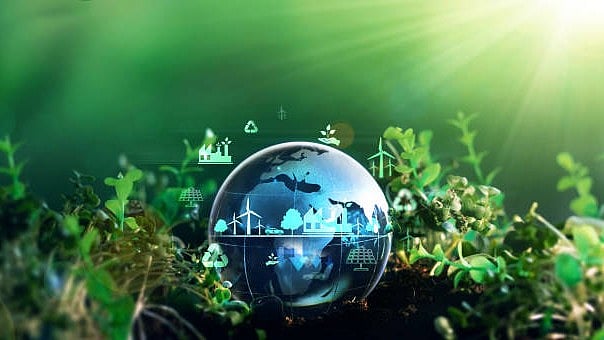
Image for representation.
Credit: iStock Photo
By David Fickling
It’s better to under-promise and over-deliver. India’s clean power industry is finally making good on that dictum.
For several years, India has fallen well short of the rosy visions proclaimed by its leaders. India should become the first major economy to industrialize without carbonizing, to paraphrase its Group of 20 sherpa Amitabh Kant. Prime Minister Narendra Modi promised to connect 500 gigawatts of clean energy by 2030, equivalent to all the generators in France, Germany and Italy put together.
The picture on the ground has, until recently, been very different. A previous aspiration to hit 175 GW by 2022 came in 40 per cent below target, and had to be fudged to avoid embarrassment. Ill-advised tariffs on solar panels, combined with contractual and political support for fossil fuels and constant changes to the rules of renewable power auctions, made matters worse.
Amid this policy chaos, wind and solar installations fell 19 per cent last year, to 13 GW. That’s less than a third the level that would be needed for the country to be on track for Modi’s 2030 plan. Coal, the dirtiest fuel and the most readily available alternative to renewables in India, took up the slack: Usage by power plants jumped by 8.8 per cent in the latest fiscal year through March. Plenty of analysts (including me) despaired about the prospects for a reversal.
The logjam, however, appears to be breaking. Solar panels and wind turbines have been springing up in 2024 like seedlings after the breaking of a drought. In the eight months through August, 18.8 GW of new renewable generators were connected, more than in the whole of 2023. Over the full year, that figure will increase to around 34 GW, the International Energy Agency forecast last week, before nearly doubling to 62 GW in 2030. Growth rates are set to overtake China in the second half of the decade and become the most rapid of any major nation, the IEA wrote.
The trend looks set to extend into next year as well. Tenders for renewable projects, a useful leading indicator, showed 70 GW of announcements and 33 GW of awards in the first half of the year alone, according to S&P Global Commodity Insights. Projects already in train would bring the total to 430 GW, renewable energy minister Pralhad Joshi told parliament in August. All but 76 GW of the total is either operating or under construction, sharply reducing the risk this is the same old case of over-promising and under-delivering.
Solar module manufacturers, encouraged by those counterproductive tariffs, have been busy building out factories. By 2026, the country will be able to assembly 172 GW of panels per year, according to Mercom India Research, a renewables consultancy. That’s sufficient to meet its own projected needs well into the 2040s, even on a pathway that takes the world to zero emissions.
While the Reserve Bank of India kept rates on hold last week, an easing of its monetary policy stance opens the way to cuts by the end of the year, which should also help: Finance costs have been one of the biggest factors holding back further renewable development in recent years.
The implications of all this could be profound. Rich countries and China each account for roughly a third of the world’s greenhouse pollution, but emissions from the former group have been declining for nearly two decades and China is likely to hit its peak this year. India, as the world’s most populous and fastest-growing major economy, is likely to be the biggest factor pushing up the world’s carbon footprint over the decades ahead.
That might be excusable in moral terms: India has barely contributed to the global climate problem so far, so can argue that countries who’ve been spewing CO2 for centuries should cut it some slack. But such rationalizations don’t offer much comfort to farmers in Uttar Pradesh hospitalized or killed by blistering summer heatwaves, or software developers in Bengaluru having to depend on water trucks because climate change is drying up the aquifers needed to keep India’s cities watered. What they need are signs that the upward trajectory of emissions is finally heading downwards.
We might be on the brink of that future. BloombergNEF estimates that an Indian power sector that was on track to install 506 GW of clean energy by the start of 2030 would see its own carbon footprint begin to decline as soon as 2026, putting the world as a whole on track to net zero emissions. Globally, we’re already installing enough solar and buying enough electric vehicles to avoid catastrophic climate change. Hitting Modi’s 500 GW target would be one more piece of the puzzle to avert that outcome.
Since coal furnaces kicked off Britain’s industrial revolution, it’s been an accepted fact that economic growth can only be bought at the cost of environmental damage. With the UK’s last coal-fired power station closing last month, that argument has been looking threadbare — and if India can now get rich without belching carbon, it may be dealt a decisive blow. For other emerging economies hoping to follow India’s development path, that would be a powerful lesson. The centuries-old nexus between pollution and wealth is finally being broken.